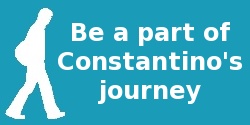Constantino Diaz-Duran is a fellow at the Center for Social Cohesion at Arizona State University. He is chronicling his walk from New York to Los Angeles to celebrate his eligibility for American citizenship. Follow Constantino’s progress.
This is part two of last week’s post.
I should start by apologizing to my readers for the delay. I ran into some problems with my computer and was unable to write. I’m also beginning to realize that I need to rethink my pace in order to be better able to manage my time. It is not easy to keep up a regularly updated journal when walking every day.
Being constantly on the move also makes it harder to go in search of the stories I promised to bring you all. This might mean a drastic change to my approach, timeframe, and perhaps even route, but when you set off on a journey like this, you need to be willing to learn as you go along and make adjustments accordingly.
 Now, back to Chuck and Jack. The first question that came into my mind – and probably to yours – upon hearing their story was “How do you do it?” According to Chuck, it’s not always, easy. “Sometimes we have to stretch it to survive, but we always make it work,” he said. They didn’t install a chicken coop on their yard to follow some Brooklyn hipster trend. They did it because they needed the eggs to help feed their children and other beneficiaries. That’s also the reason for the garden and the fruit trees.
Now, back to Chuck and Jack. The first question that came into my mind – and probably to yours – upon hearing their story was “How do you do it?” According to Chuck, it’s not always, easy. “Sometimes we have to stretch it to survive, but we always make it work,” he said. They didn’t install a chicken coop on their yard to follow some Brooklyn hipster trend. They did it because they needed the eggs to help feed their children and other beneficiaries. That’s also the reason for the garden and the fruit trees.
“A great thing about America,” says Chuck, “is that you are free here to create a world for yourself, and that allows you to be resilient.” He sees resilience as one of the most prominent American trends. Pressed for an example, he brings up New York City and the way it just kept going after 9/11. “I don’t think you can stop anybody in New York,” he said. “And look at New Orleans after Katrina; it was slow, but the city stood up again.” I think he has a point. It seems Americans, north and south, are resilient and, to repeat Chuck’s words, “always make it work.”
As I listened to Chuck talk about the resilience of Americans in New York and New Orleans, I couldn’t help but think about his own city. This year marks the 150th anniversary of the start of the Civil War. This, I found, is a much bigger deal in Richmond than anywhere else I’ve been. I’m not surprised. It makes sense that the capital of the Confederacy would remember this event with more ardor than the rest of the county. And while people here have clearly not forgotten the war that devastated their region, Chuck’s comment helped me look at it from a fresh angle. It got me wondering how this American resiliency was manifested here.
As I walk through the South (I am now in North Carolina), I am keeping an eye out for the rebuilding not of infrastructure, but of human relations. These take a lot longer to fix than a building does. I talked about it with my friend Sarah, who moved to a suburb of Richmond after living in Oregon and California. She grew up in Alaska and Pennsylvania, and I met her when we were in college in Maryland.
Sarah, a reporter with a local newspaper, has had some trouble adjusting to life in the south, but overall she seems happy. She rolls her eyes at guys who have decked out their trucks with oversized wheels, and laughs when these trucks bear stickers reading “Jack ‘em up high, fat chicks can’t jump.” And while she gets annoyed by both men and women treating her like she’s just “a cute girl writing a nice little article,” her job has allowed her to get to know the people here and to understand their values.
 Thinking of resilience, and the rebuilding of human bonds, I asked her about racial relations. According to her, one of the most surprising things about living in the South is that there is a lot more integration here than there is in the North. It’s not that there’s no tension; it’s just that people of different races seem more likely to work side by side, and live in the same neighborhoods here than they are above the Mason-Dixon Line. Sarah points out that the part of Philadelphia she grew up in was predominantly white. Down here, these boundaries are not that clearly marked.
Thinking of resilience, and the rebuilding of human bonds, I asked her about racial relations. According to her, one of the most surprising things about living in the South is that there is a lot more integration here than there is in the North. It’s not that there’s no tension; it’s just that people of different races seem more likely to work side by side, and live in the same neighborhoods here than they are above the Mason-Dixon Line. Sarah points out that the part of Philadelphia she grew up in was predominantly white. Down here, these boundaries are not that clearly marked.
I see this as resilience. A war was fought in this land to ensure the freedom of an entire race. A civil movement was later launched here to ensure other rights. The parts of the country where I’m now walking have been torn many times before. Yet it seems that the same resiliency that keeps people like Chuck and Jack going is alive and well here. Racial relations here may not yet be perfect, but that hasn’t stopped people of different backgrounds from working together.
Be a part of Constantino’s journey.
Follow Constantino on Facebook and Twitter.
See Constantino’s entire route.
*Photo by Constantino Diaz-Duran.




Send A Letter To the Editors